Singara Recipe | Bengali Shingara
For any other person, a samosa, when travels to the land of Bengal, takes the form of a Shingara. But try saying that to a Bengali, they may take offense in it. Of course, some similarities between the two do exist, but for a Bengali person, a Singara is another emotion in itself. And they really may not argue on this, any further. Here’s my version of this famous tea time snack with a vegetable stuffing of aloo (potato), phulkopi (cauliflower) and matar (green peas).
Singara vs Samosa
It can be rightly said that the Singara is a prized possession for a Bengali. More so, when it is the Aloo Phulkopir Shingara, which is simply the one stuffed with a specially spiced mixture of potatoes and cauliflower.
Since, even the samosa’s origin is believed to be in Central Asia and not particularly India, the Bengal one is also a variation just like the Punjabi or other North Indian ones.
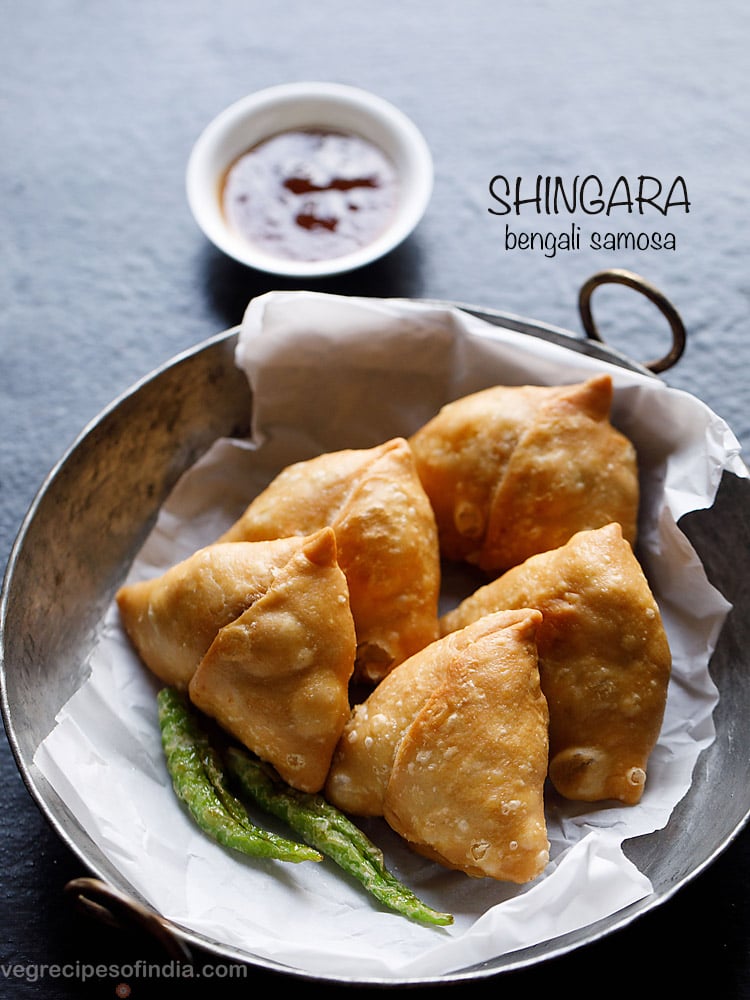
While the process of making a Singara may be same as that of a Punjabi Samosa, but the flavors are completely different. So, if you are expecting the taste of a Punjabi samosa in a Shingara, then its definitely not going to be met.
More differences include:
- Unlike the faint tanginess present in a regular samosa, there’s a hint of sweetness, crunchiness from the peanuts and an earthiness from the cauliflower and potatoes in a Singara.
- While a samosa usually has a thicker outer covering, a classic Singara primarily has a thin, flaky covering. The Bengali stuffings can range from the vegetarian aloo-phulkopi to even a non-vegetarian one.
- The size of the Shingara is generally smaller than that of a samosa. It is also a lighter and crispier puff pastry as compared to samosas.
- However, shaping Singara in its signature style requires as much effort and precision as shaping its Punjabi counterpart.
About Singara Recipe
Aloo Phulkopir Singara is usually a winter specialty in Bengal due to the arrival of fresh seasonal produce like cauliflower and green peas. Thus, these go in the preparation of the filling of the much-celebrated Shingara. In this recipe, you can skip both cauliflower and green peas, and add more potatoes instead.
I have used the traditional Bengali mix of 5 spices called panch phoron in this recipe. This spice blend is composed of wild celery seeds (radhuni), fenugreek seeds (methi), fennel seeds (saunf), nigella seeds (kalonji) and cumin seeds (jeera).
In case you don’t have the panch phoron, just add a pinch each of these 5 spices. In case you’re finding it difficult to source the radhuni, add mustard seeds (rai/sarson) or carom seeds (ajwain) instead. Or better, prepare this spice mix by referring to this Panch Phoron recipe.
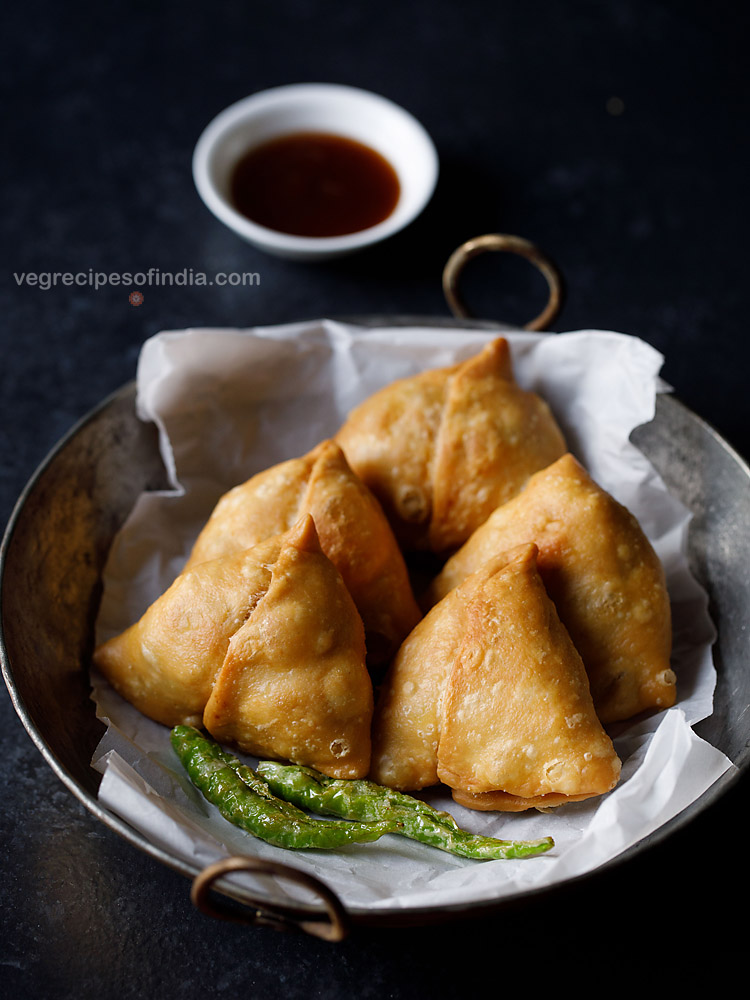
Just like the samosa, a Singara is deep fried too. But you can bake or air fry it too. If baking the Shingara, check the method on how to go about it in this Samosa Recipe.
Making the Singara does take some time and efforts. This recipe yields about 14 Shingara, you can halve or double the recipe if you wish to.
Serving Aloo Phulkopir Shingara, alongside some green chutney, tamarind chutney or mint coriander chutney, as an evening snack is the best thing you can do. You can also have it with some fried green chilies.
How to make Singara
Prep Vegetables
1. Rinse and then chop 150 grams cauliflower in tiny or small florets. You will need 1.5 cups small cauliflower florets.
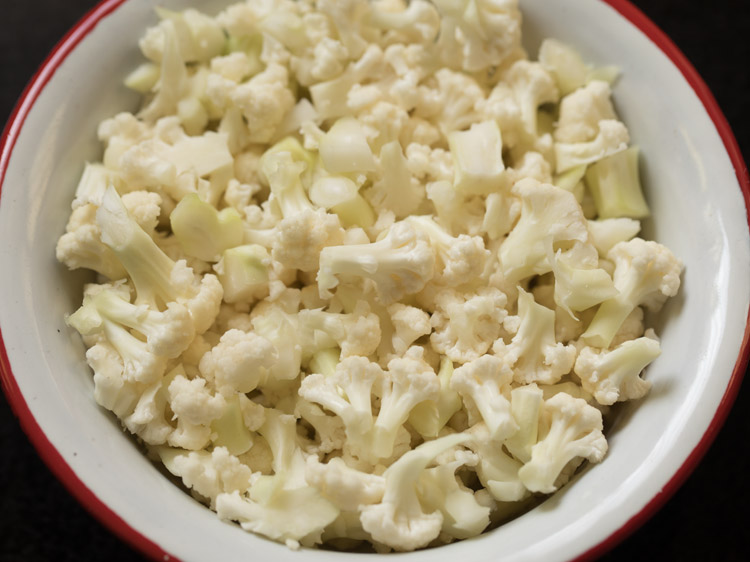
2. Rinse 1 cup fresh green peas and keep aside.
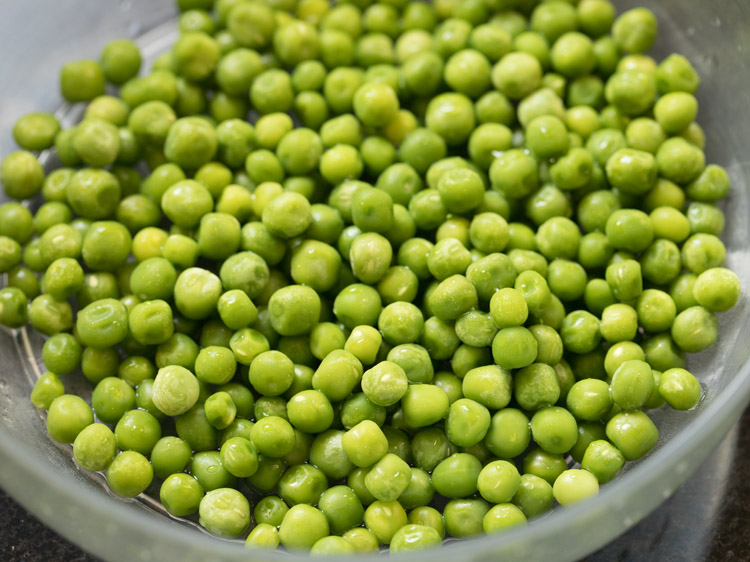
3. Rinse, peel and chop 225 grams (3 medium) potatoes in small cubes. You will need 1.25 cups small potato cubes.
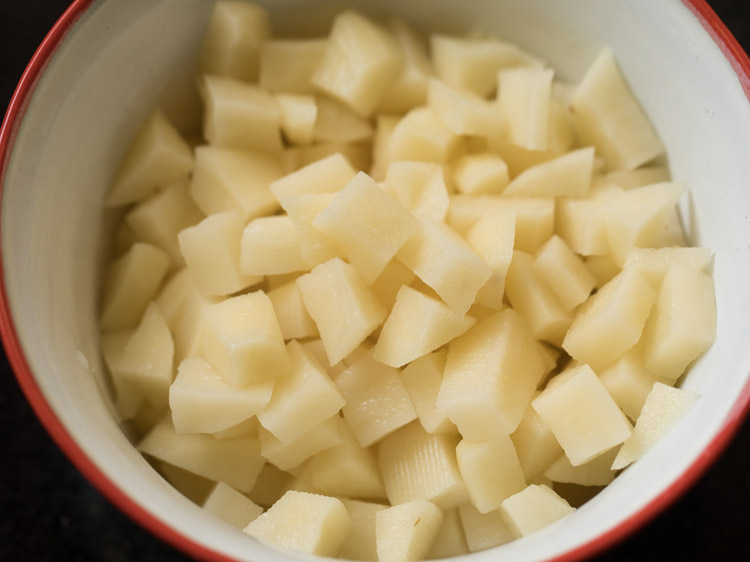
Make Stuffing
4. Heat 1 tablespoon oil in a pan. Add ½ teaspoon panch phoran.
In case you do not have panch phoran, add a pinch of each the following spices:
- fenugreek seeds (methi)
- wild celery seeds (radhuni)
- fennel seeds, cumin seeds
- nigella seeds (kalonji) – instead of wild celery seeds (radhuni), you can use carom seeds (ajwain) or mustard seeds (rai).
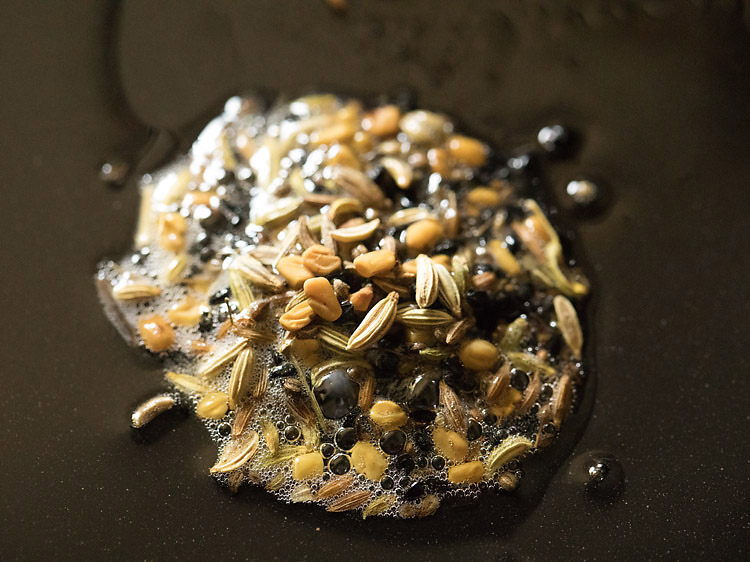
5. Fry the panch phoron on low heat till the spices turn aromatic and splutter.
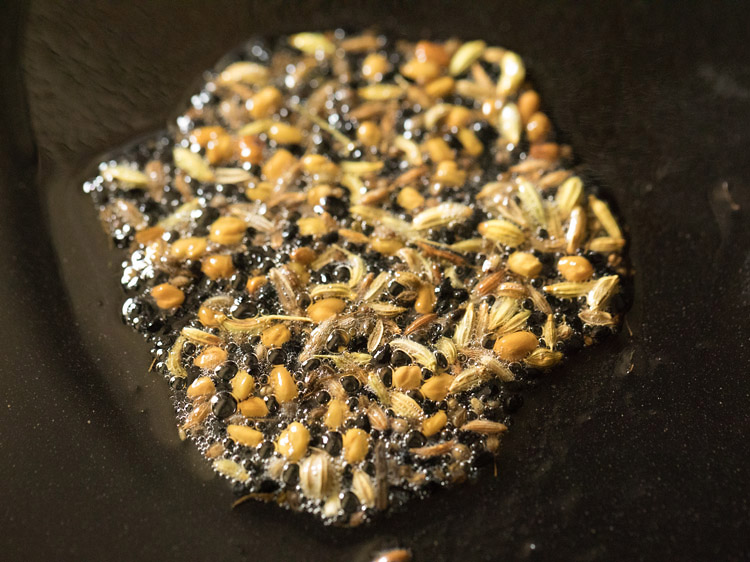
6. Next add ⅓ cup chopped onions.
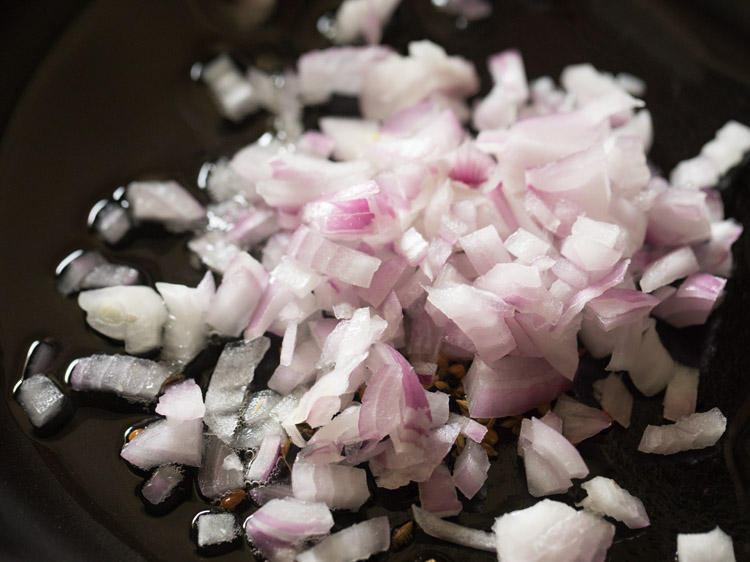
7. Stir and sauté till the onions soften and turn translucent.
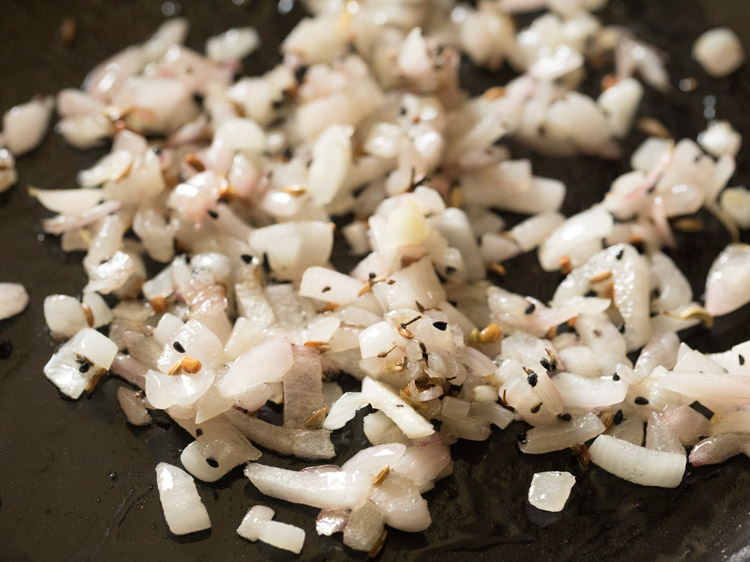
8. Then, add 1 teaspoon ginger paste. Mix and sauté till the raw aroma of the ginger goes away.
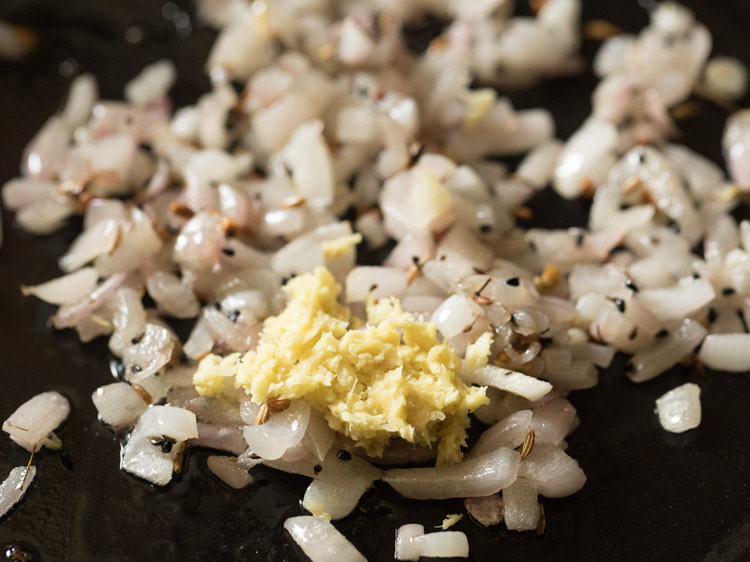
9. Keep the heat to low, add ¼ teaspoon turmeric powder, ½ teaspoon Kashmiri red chili powder, ½ teaspoon coriander powder and ½ teaspoon cumin powder.
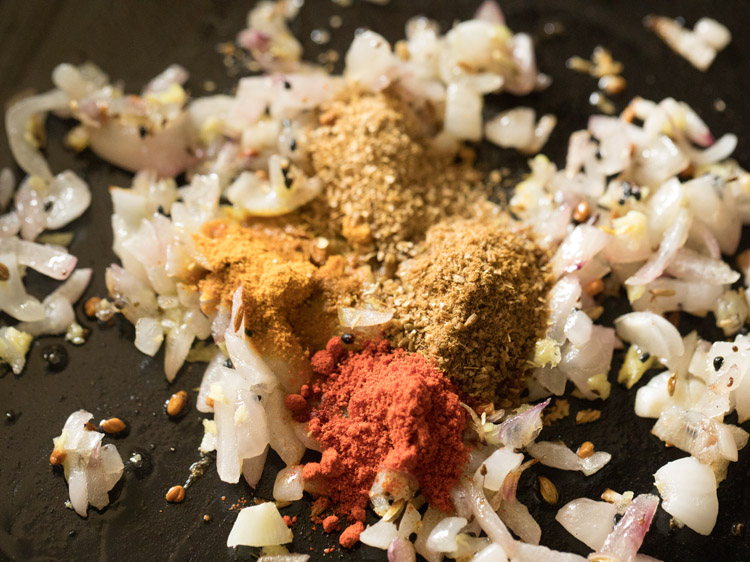
10. Mix very well and sauté for a few seconds.
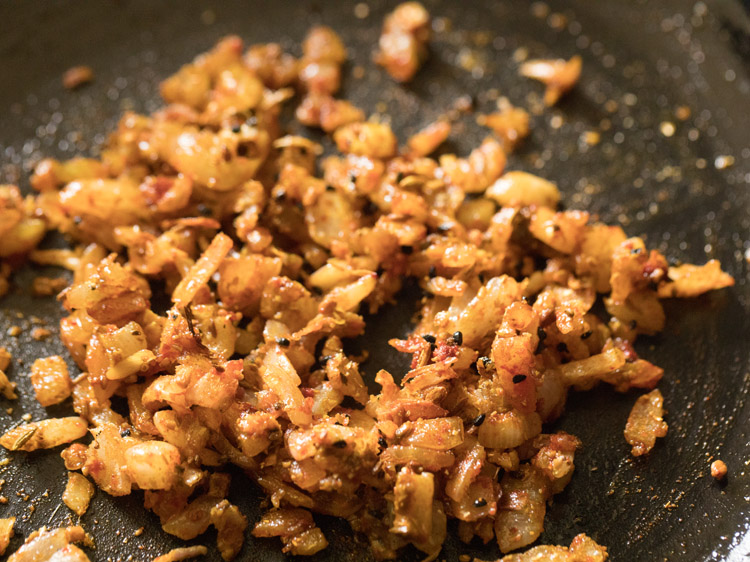
11. Add the chopped potatoes.
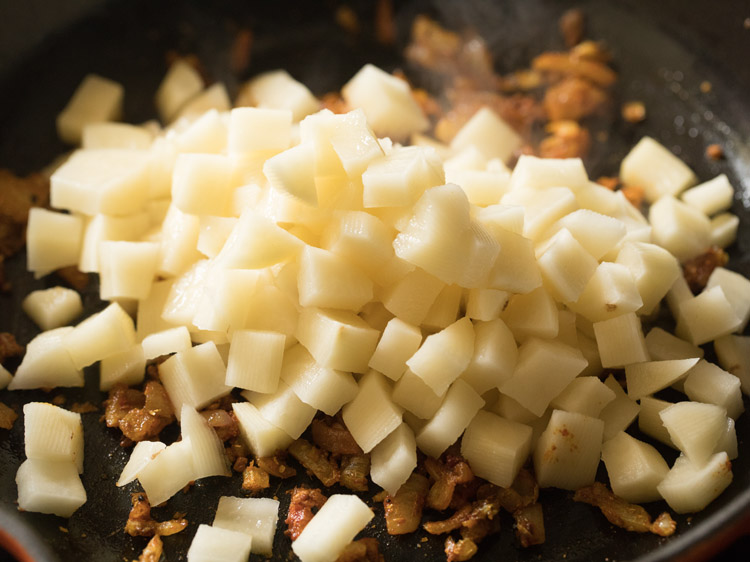
12. Mix and sauté for 1 minute.
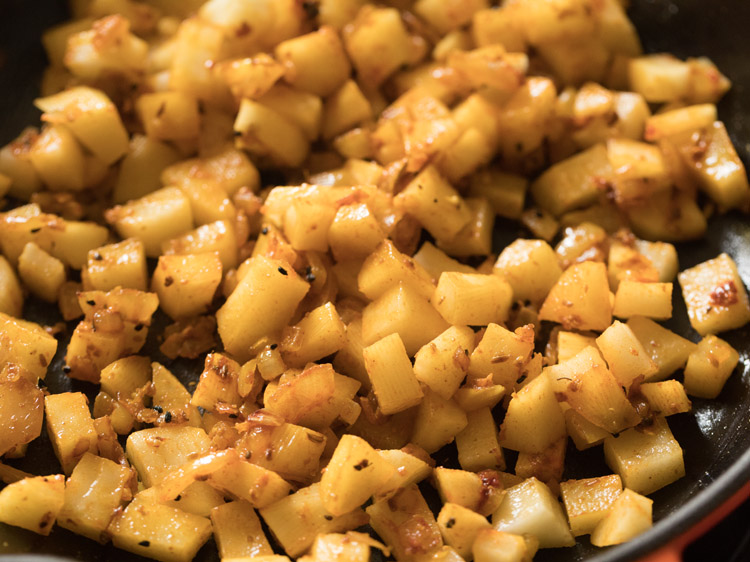
13. Then, add the chopped cauliflower and green peas.
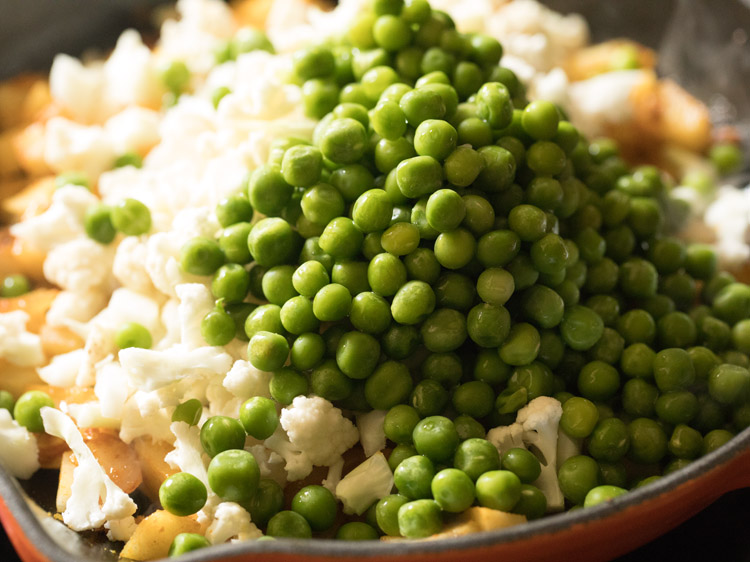
14. Season with salt as per taste.
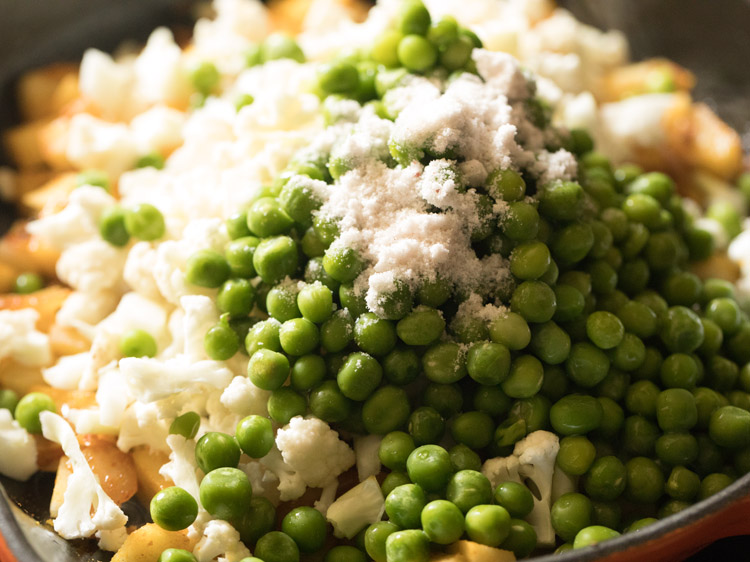
15. Mix very well.
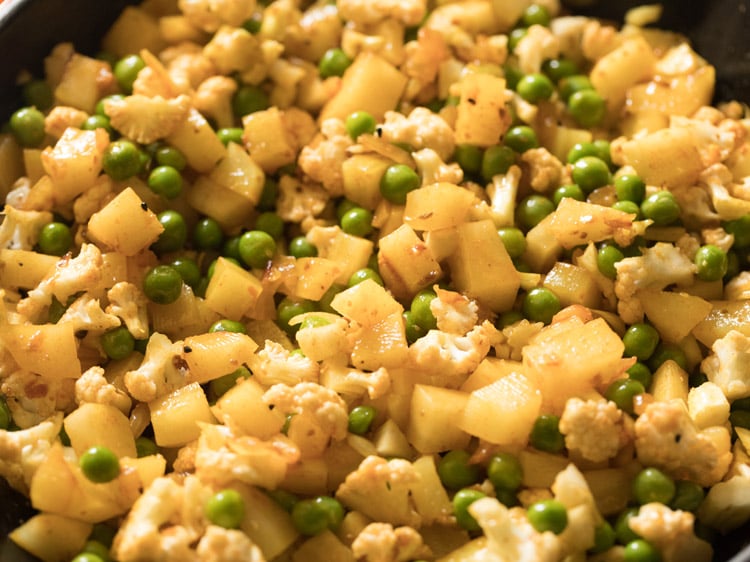
16. Add 4 to 5 tablespoons water and mix again.
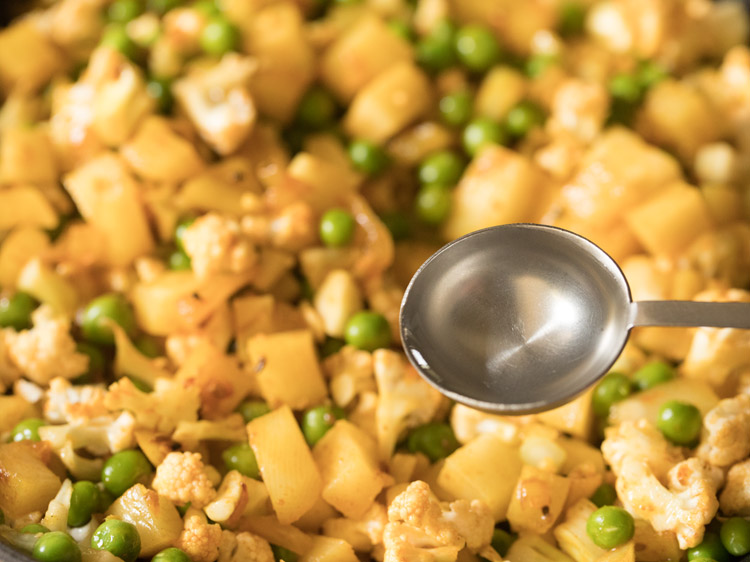
17. Cover the pan with a lid and simmer the vegetables on low to medium-low heat.
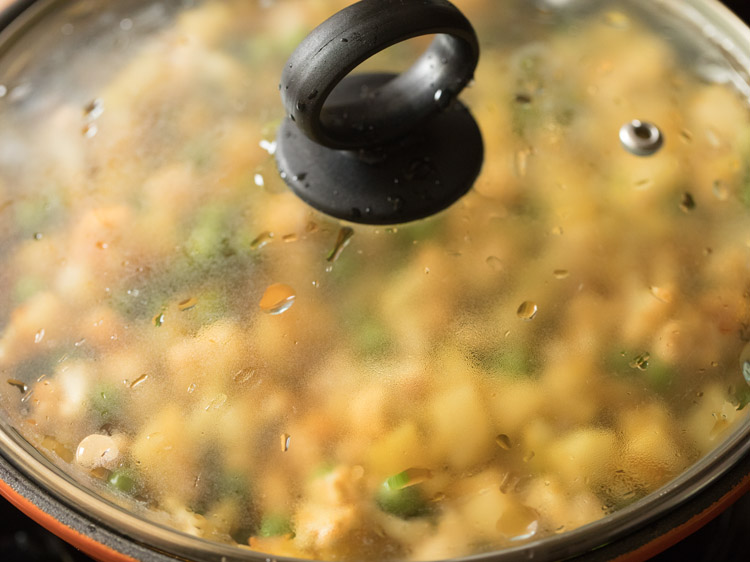
18. In between, check. If the vegetables start sticking to the pan, add a few more tablespoons of water.
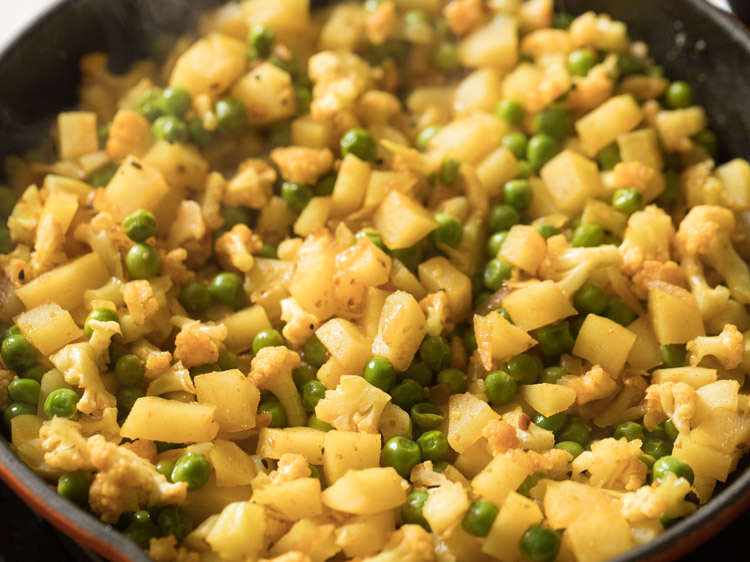
19. Simmer till the vegetables are tender and cooked. Then, switch off the heat. Just cook the vegetables till tender. Do not make them mushy or overcook them.
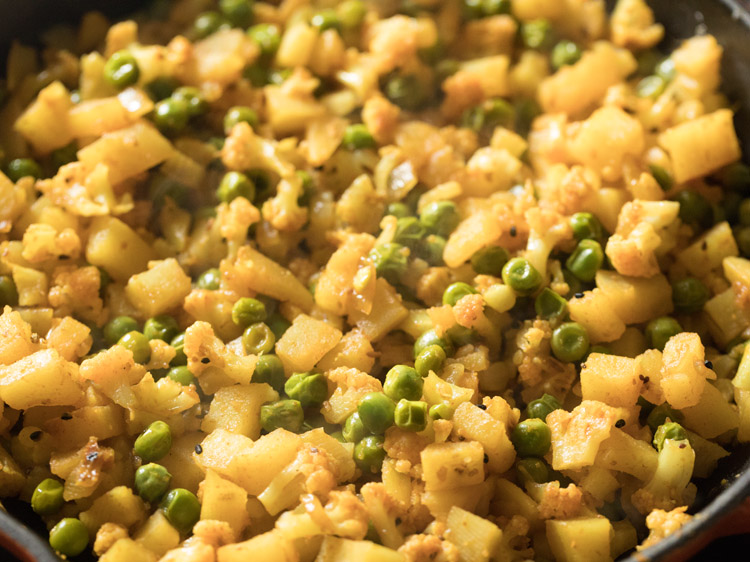
20. Add 3 tablespoons roasted peanuts or salted peanuts and ¼ teaspoon sugar.
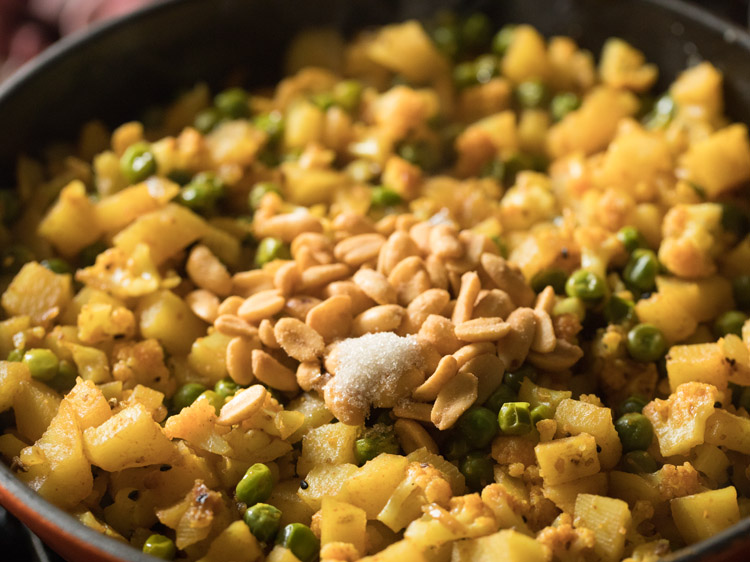
21. Mix well and let this stuffing cool to room temperature.
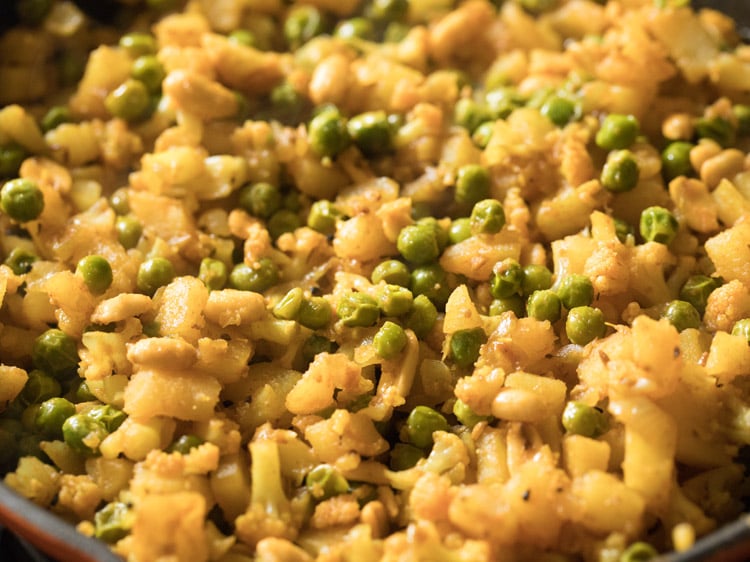
Make Singara Dough
22. In a large parat (plate) or a bowl, take 2 cups all-purpose flour. Add 4 tablespoons oil and 1 teaspoon salt or as required.
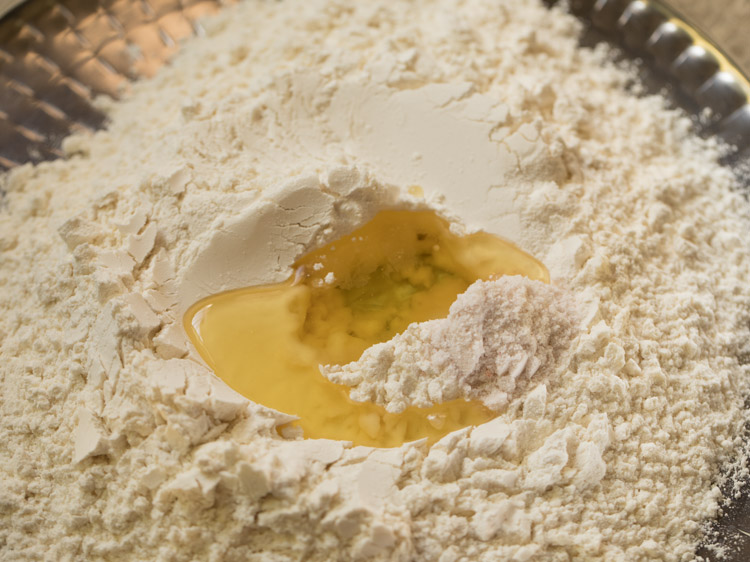
23. Mix the oil in the flour with your fingertips till you get a breadcrumb like texture in the flour.
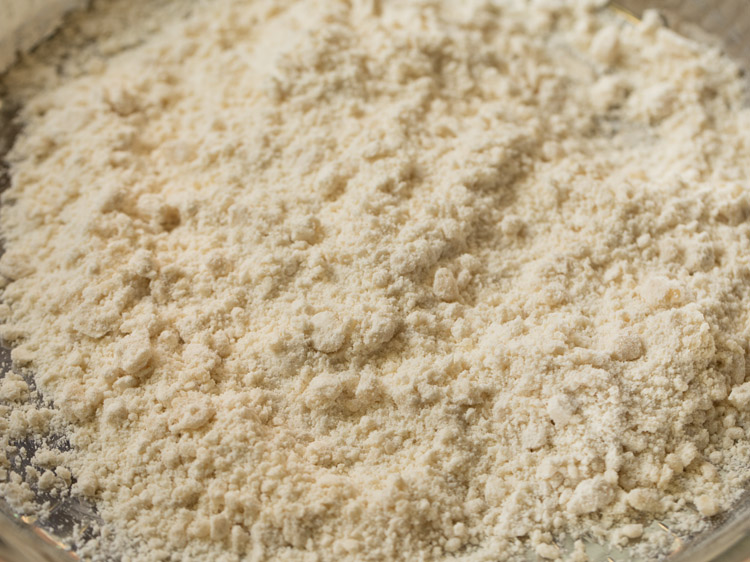
24. When you press a portion of the mixture in your palm, it should hold together and not crumble.
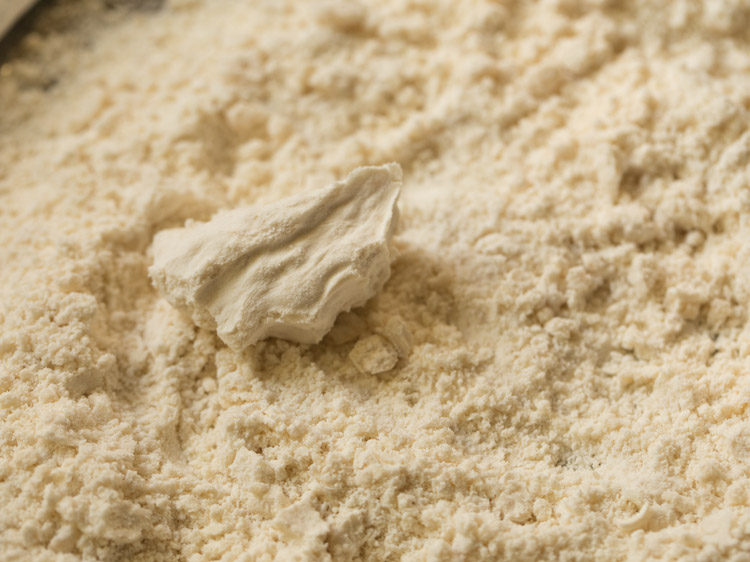
25. No, add ½ to ⅔ cup water or as required. Add water in parts.
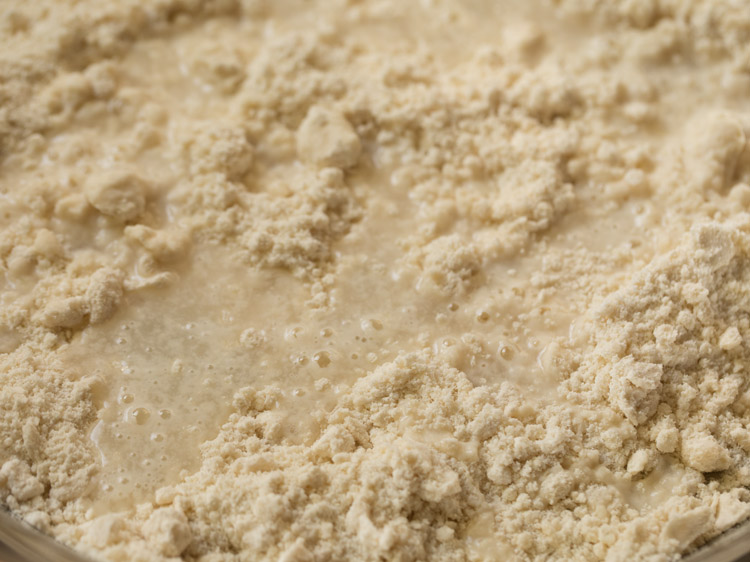
26. Knead to a smooth dough. The dough should be smooth but firm or tight. It should not be soft.
Cover the dough with a moist cloth or kitchen napkin and allow to rest for 30 minutes.
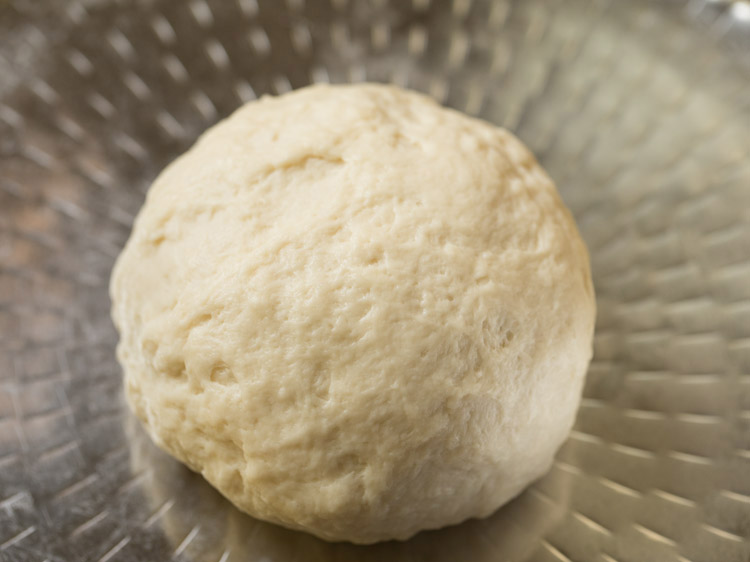
27. After 30 minutes, lightly knead the dough again and make a log. Cut the dough log in equal pieces. Cover the pieces with a moist cloth or kitchen napkin.
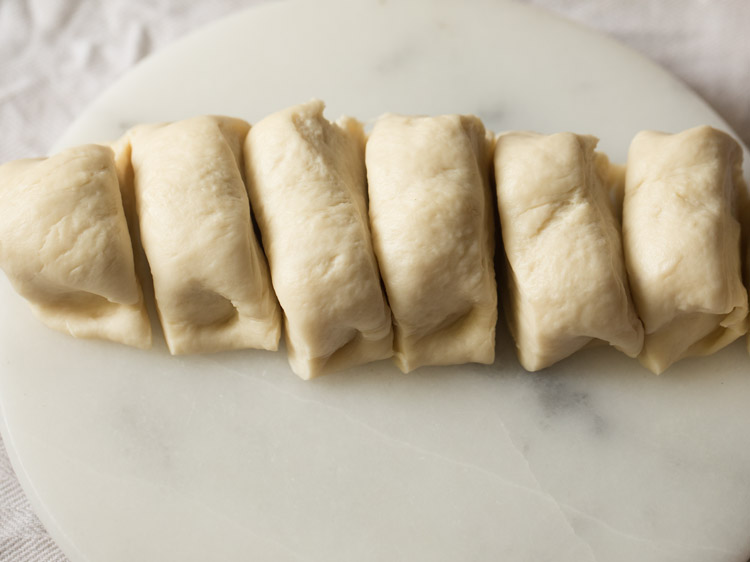
Shaping Singara
28. Take one dough piece and roll in a ball. Flatten and keep on the rolling board.
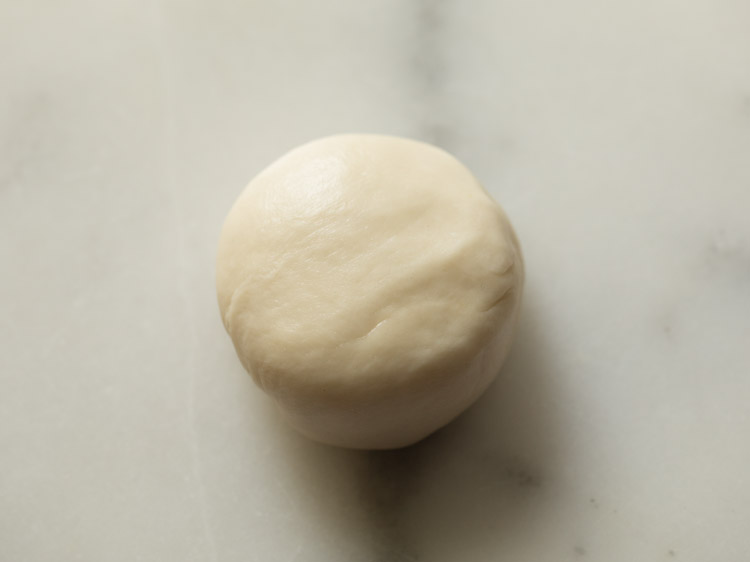
29. With a rolling pin, roll to a 7 to 8 inches disc.
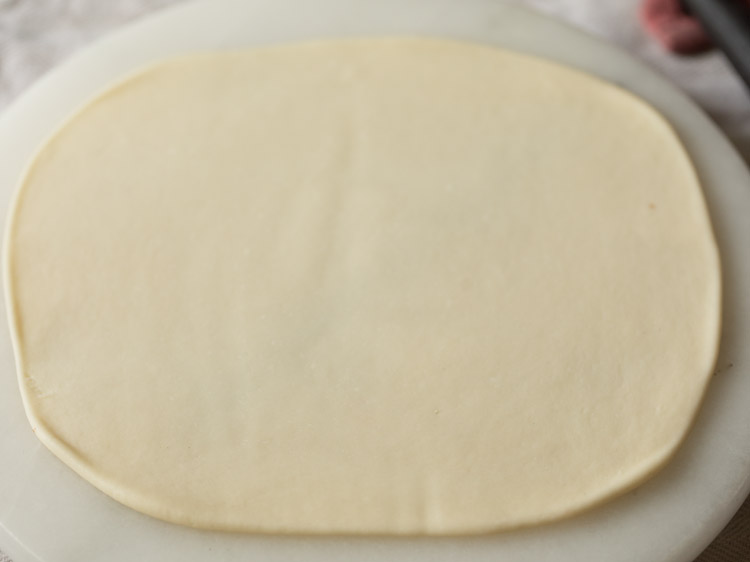
30. Cut the rolled dough from the center.
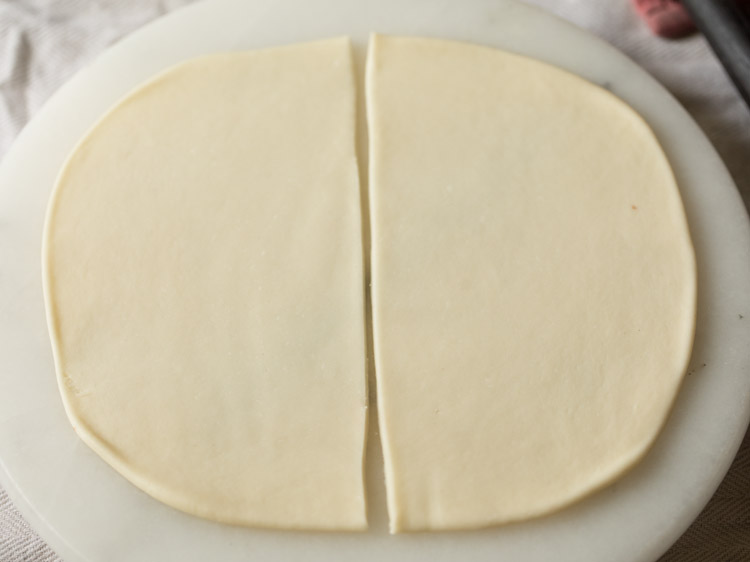
31. Now, with your fingertip or with a small brush, spread water on the edges of one of the cut dough.
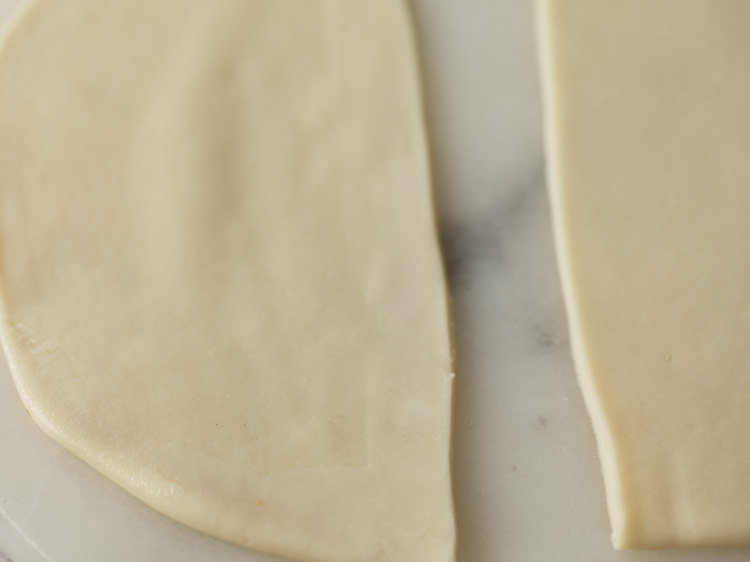
32. Bring together the straight edge with one of its end overlapping a bit the other end. Press and seal the edges. Press the edges well, so that they get sealed. It will look like a cone.
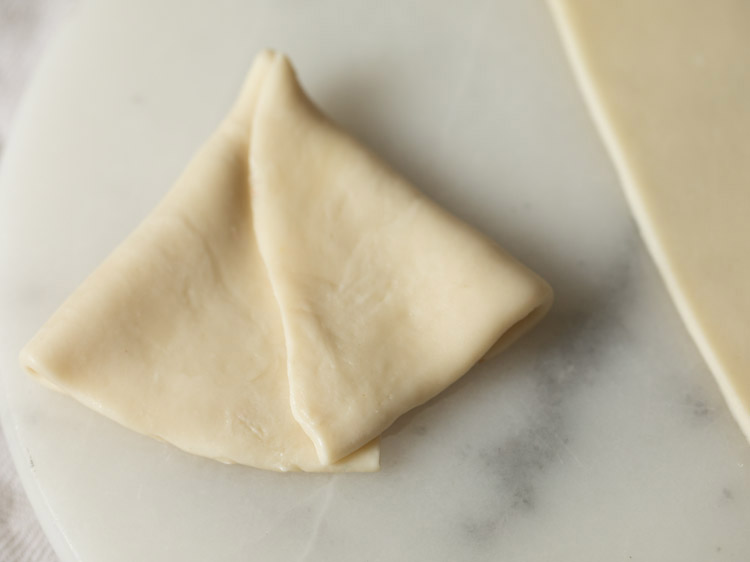
33. Now with a small spoon, fill the cone with the prepared stuffing. Remember not to underfill or overfill with the veggie stuffing.
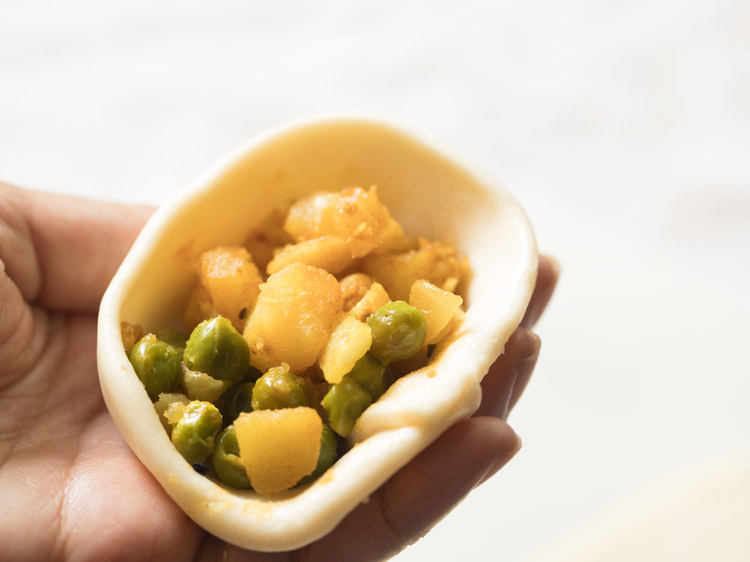
34. Pinch a part on the edge as shown in the picture below. This helps the singaras to stand when placed on a tray.
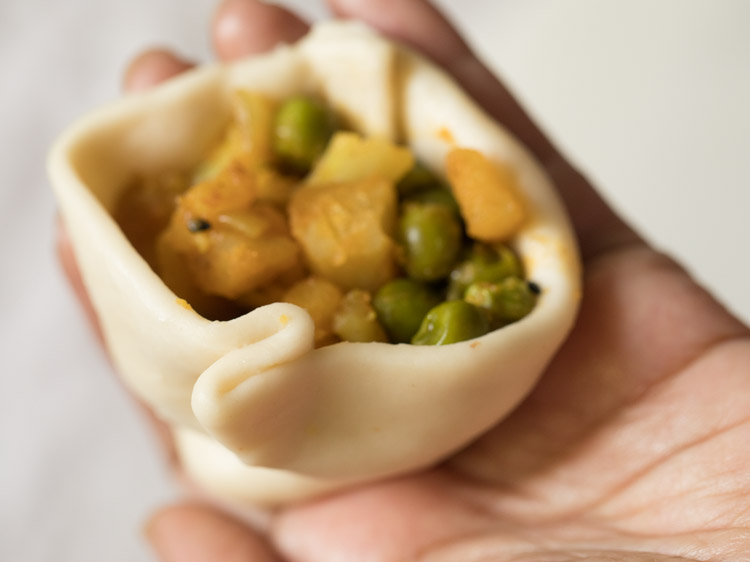
35. Press both the edges. Be sure there are no cracks. The edges should be joined very well.
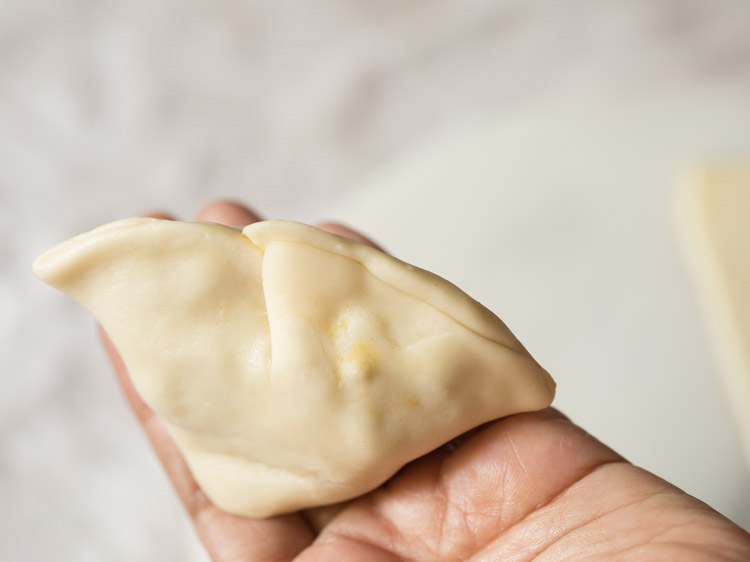
36. Make all shingaras this way. Cover with a moist cloth or kitchen napkin before you begin to fry them.
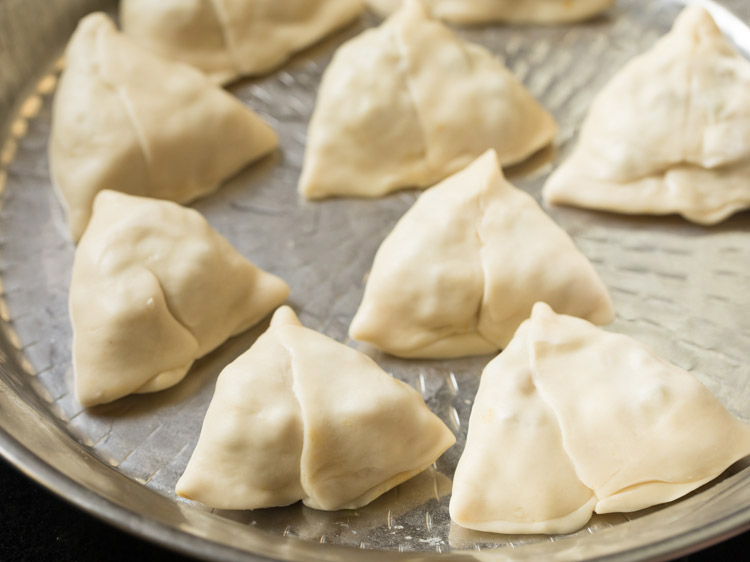
Deep Frying Singara
37. Heat oil for deep frying in a kadai on medium flame. Add a small piece of the dough and it should come up gradually and steadily.
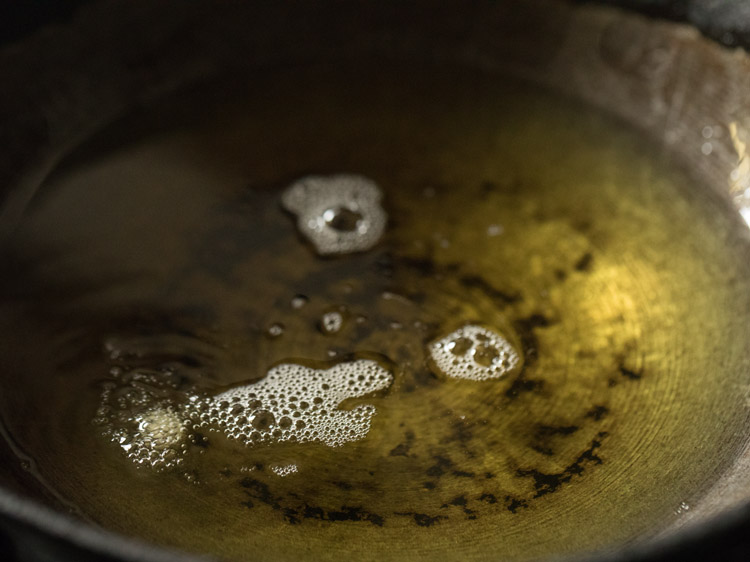
38. When the oil is moderately hot, gently place the prepared Singara in the hot oil.
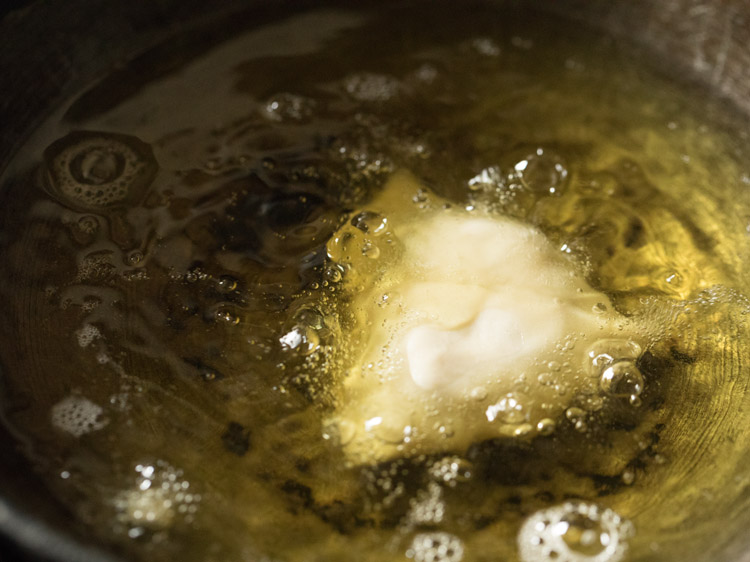
39. Add 2 to 3 or 4 singara depending on the size of the kadai.
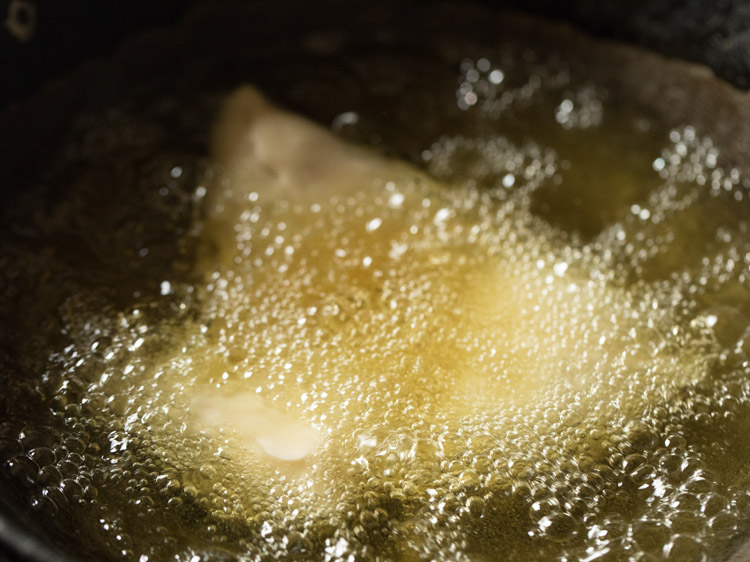
40. Once the singara are added, then lower the heat.
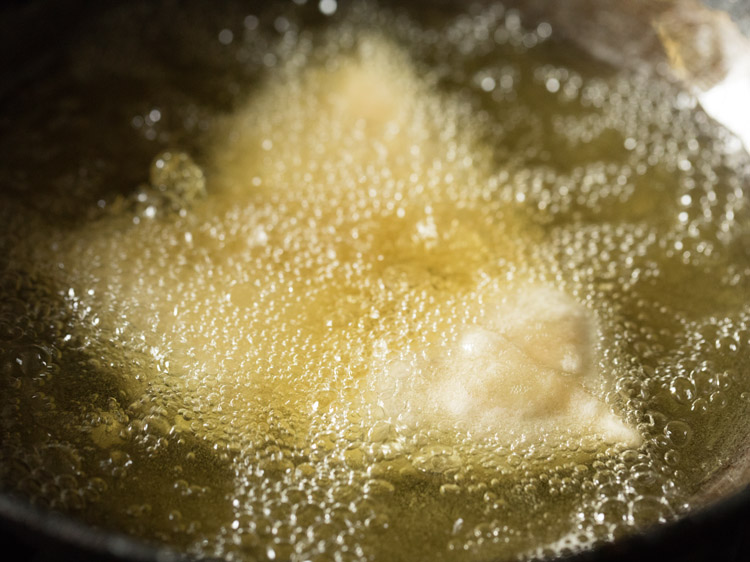
41. Begin to fry them on low to medium-low heat.
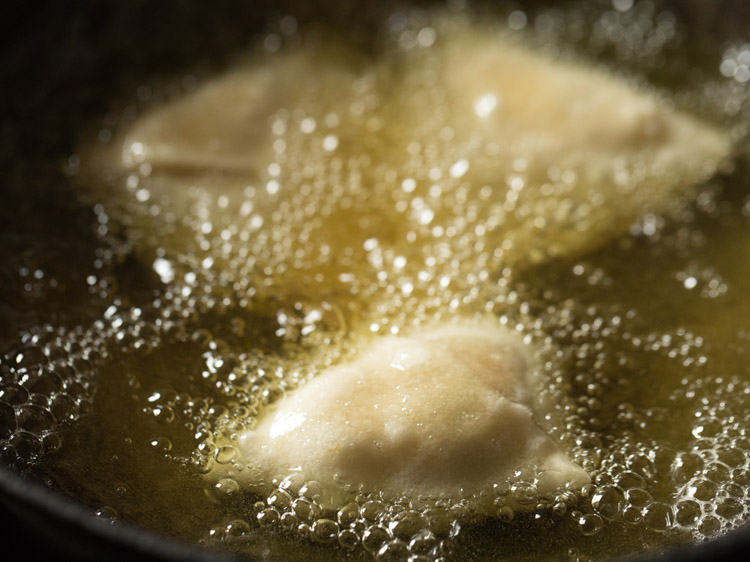
42. When one side is light golden, turn over.
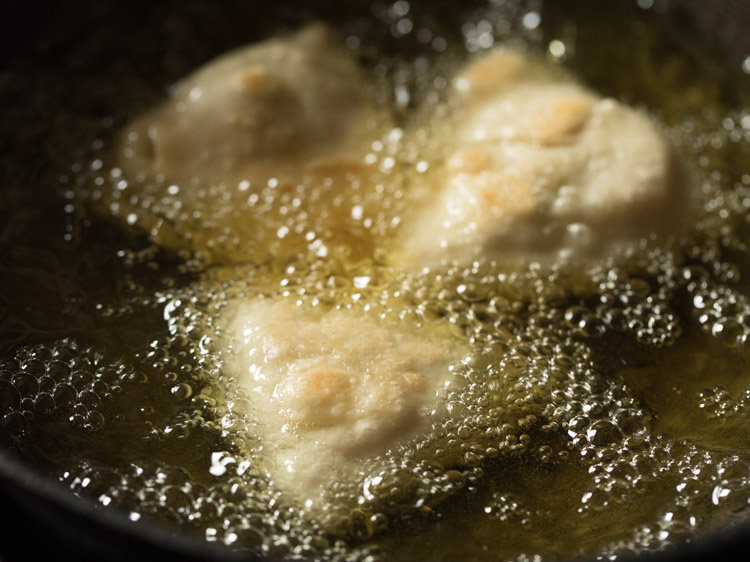
43. Continue to fry and when the second side is light golden, turn over again.
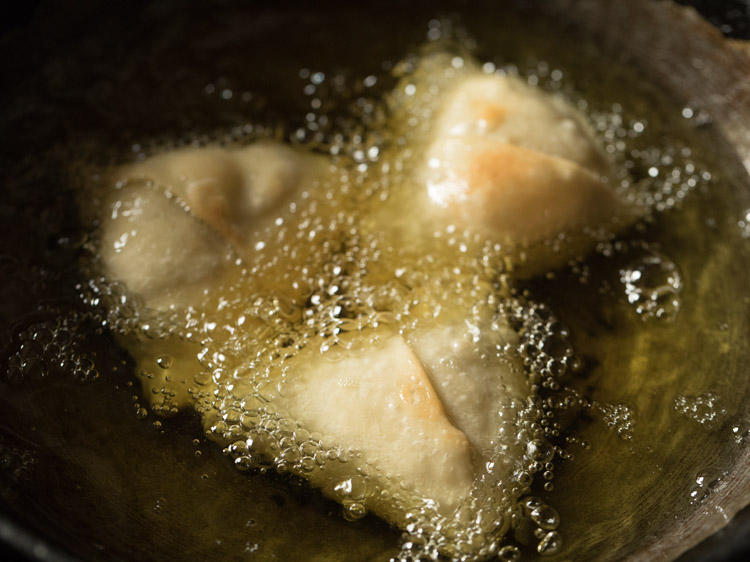
44. This way keep on turning them and frying till they have a nice golden crust.
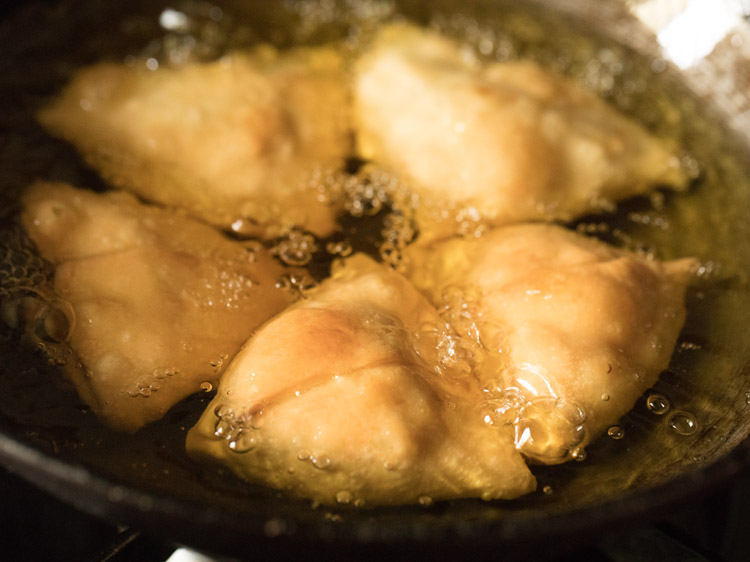
45. Remove with a slotted spoon, draining the extra oil.
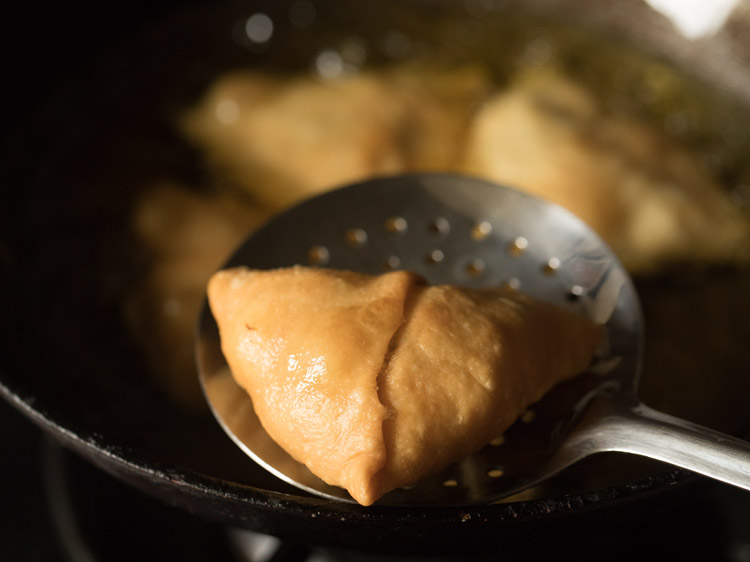
46. Place them on kitchen paper towels to absorb extra oil. While frying other pieces, slightly increase the heat. Add them and again reduce the heat.
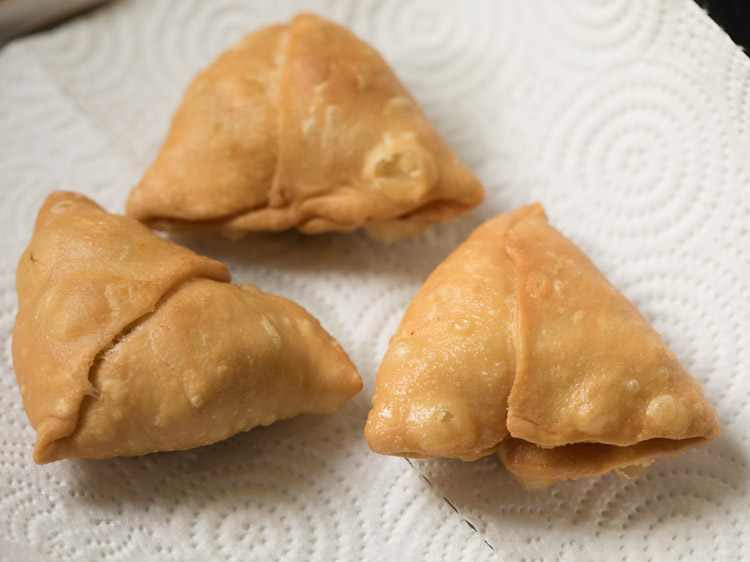
47. Serve Aloo Phulkopir Shingara hot or warm with some fried salted green chillies, green chutney, tamarind chutney or mint coriander chutney.
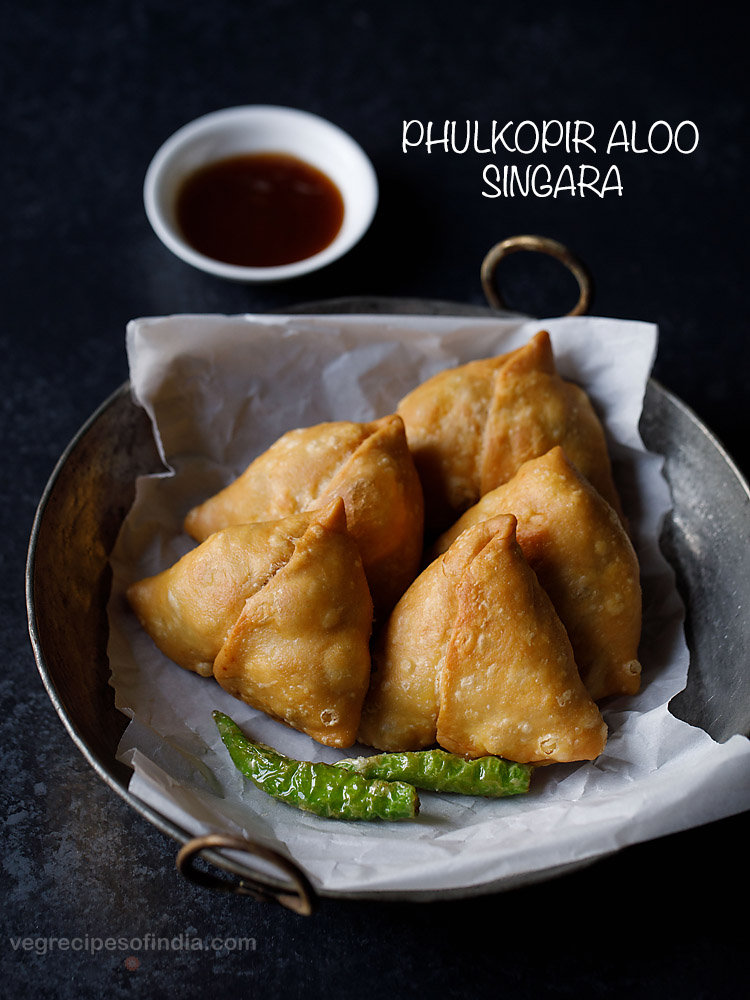
FAQs
What is samosa known in West Bengal?
It is usually called as Shingara or Singara. But, is different than the Punjabi samosa.
How do you make the crust for a Bengali Singara?
Take about 2 cups all-purpose flour (maida) in a large plate or parat. Add 4 tablespoons oil and 1 teaspoon salt to it. Use your fingertips to mix till a breadcrumb like texture is achieved.
Press and check, the mixture should not crumble. Then, start adding ½ to ⅔ cup water in parts, and knead to a smooth, but slightly firm dough.
This dough has to be covered with a damp cloth and kept to rest for 30 minutes. After this time, lightly knead it once again and make a log. Divide into equal portions and cover with a moist cloth until ready to stuff.
How is a Singara different than samosa?
Singara and samosa are close related, but definitely not similar. The main differences are: Shingara has a sweeter and crunchier filling as compared to the slightly tangy filling of samosas.
Samosas are usually larger in size than their Bengali counterpart and singaras usually have a thin, flaky outer crust versus the thicker outer crust of samosas.
Step by Step Photo Guide Above
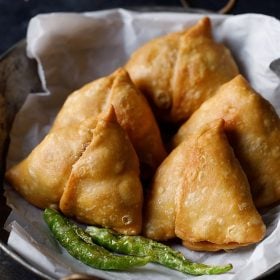
Ingredients
For the vegetable stuffing
- 150 grams cauliflower or 1.5 cups chopped tiny cauliflower florets
- 225 grams potatoes or 3 medium potatoes or 1.25 cups chopped small potato cubes
- 1 cup green peas – fresh, 135 grams
- 1 tablespoon oil
- ½ teaspoon Panch Phoron
- ⅓ cup onions – finely chopped, 60 grams or 1 medium-sized
- 1 teaspoon ginger paste or 1 inch ginger, crushed to a fine paste in mortar-pestle
- ¼ teaspoon turmeric powder
- ½ teaspoon Kashmiri Chilli Powder
- ½ teaspoon Coriander Powder
- ½ teaspoon Cumin Powder
- 4 to 5 tablespoons water or add as required
- salt as required
- ¼ teaspoon sugar or add as required
- 3 tablespoons roasted peanuts or salted peanuts
For singara crust
- 2 cups all-purpose flour
- 4 tablespoons oil
- 1 teaspoon salt or add as required
- ½ to ⅔ cup water or add as required
Other ingredient
- oil as required for deep frying
Instructions
Preparation
- Rinse and then cauliflower in tiny or small florets. You will need 1.5 cups chopped small cauliflower florets.
- Rinse fresh green peas with water a few times and keep aside.
- Rinse, peel and chop the potatoes in small cubes. You will need 1.25 cups chopped small potato cubes.
Making vegetable filling
- Heat 1 tablespoon oil in a pan. Add ½ teaspoon panch phoron.
- On a low heat, let the spices become aromatic and splutter.
- Now add finely chopped onions. Stir and saute till the onions soften and turn translucent.
- Then add ginger paste. Mix and sauté fo a few seconds or till the raw aroma of ginger goes away.
- Then add turmeric powder, kashmiri red chilli powder, coriander powder and cumin powder. Mix very well and saute for a few seconds on low heat.
- Add the chopped potatoes. Mix and sauté for 1 minute.
- Then add the chopped cauliflower and green peas. Season with salt as per taste. Mix very well.
- Add 4 to 5 tablespoons water and mix again.
- Cover the pan with a lid and simmer the veggies on a low to medium-low heat.
- In between do check and if the veggies start sticking to the pan, then add a few more tablespoons of water.
- Simmer till the veggies are tender and cooked. Then turn off the heat. Just cook the veggies till fork tender. Do not make them mushy or overcook them.
- Then add roasted peanuts or salted peanuts. Also add sugar.
- Mix well and let this aloo phulkopir stuffing cool at room temperature.
Making singara dough
- In a large parat (plate) or a bowl take all-purpose flour (maida). Add 4 tablespoons oil and 1 teaspoon salt or add as required.
- Mix the oil in the flour with your fingertips till you get a bread crumb like consistency in the flour.
- When you press a portion of the mixture in your palm, it should hold together and not crumble.
- Now add ½ to ⅔ cup water or add as required. Add water in parts.
- Knead to a smooth dough. The dough should be smooth but firm or tight. It should not be soft.
- Cover the dough with a moist cloth or kitchen napkin and allow to rest for 30 minutes.
- After 30 minutes, lightly knead the dough again and make a log. Cut the dough log in 7 equal pieces.
- Cover the pieces with a moist cloth or kitchen napkin.
Stuffing and shaping singara
- Take one dough piece and roll in a ball. Flatten and keep on the rolling board.
- With a rolling pin roll to a 7 to 8 inches round.
- Cut the rolled dough from the center. Now with your fingertip or with a small brush spread water on the edges of one of the cut dough.
- Bring together the straight edge with one of its end overlapping a bit the other end. Press and seal the edges. Press the edges well, so that they get sealed. It will look like a cone.
- Now with a small spoon, stuff the potato filling in the samosa cone.
- Pinch a part in the edge and press both the sides. This helps the singara to stand when placed on a tray.
- Make sure there are no cracks. The edges should be joined very well.
- Make all singara this way. Cover them with a moist cloth or kitchen napkin before you begin to fry them.
Frying singara
- Heat oil for deep frying in a kadai on medium flame. Add a small piece of the dough and it should come up gradually and steadily.
- Now gently add the singara in the moderately hot oil. Add 2 to 3 or 4 shingara depending on the size of the kadai.
- Once all the singaras are added, then lower the heat. Begin to fry them on a low to medium-low heat.
- When one side is light golden then turn over each singara.
- Continue to fry and when the second side is light golden, turn over again.
- This way keep on turning them and fry till they have a nice golden crust.
- Remove with a slotted spoon draining the extra oil.
- Place them on kitchen paper towels to absorb extra oil. While frying other batches of shingara, slightly increase the heat. Add singara and again reduce the heat.
- Serve Aloo Phulkopir Singara hot or warm with some fried salted green chilis, tamarind chutney or coriander chutney or mint chutney or green chutney.
Notes
- In case if you do not have panch phoran, then just add 2 pinches each of the following spices – fenugreek seeds (methi), wild celery seeds (radhuni), fennel seeds (saunf), cumin seeds (jeera), nigella seeds (kalonji).
- Instead of wild celery seeds (radhuni) you can use carom seeds (ajwain) or mustard seeds (rai).
- Adjust the seasonings and spices according to your taste preferences.
- Instead of oil added when kneading the dough, you can also use ghee.
- Omit salted peanuts if you want to make a nut-free singara version.
Nutrition
This Singara recipe from the archives, originally published in December 2017 has been updated and republished on February 2023.


yummy!!
Hello..i did as you said but while frying edges are opening and fillings are coming out in oil. Pls help how to fix this.. I tried 4 and 3 of them opened..and still remained 7 to fry. I am scared if I will fry again it will be the same. What can I do to correct it.
use some more water at the edges. keep the edges slightly thick. press them well so that the filling does not leak out. also do not roll the dough thin for singara. you can even make a slightly thick paste of maida + water and spread it on the edges. this will also seal the edges well. if you have shaped all the 7, then just make a paste of thick maida and water and spread it on the edges. this will cover the edges. hope this helps.